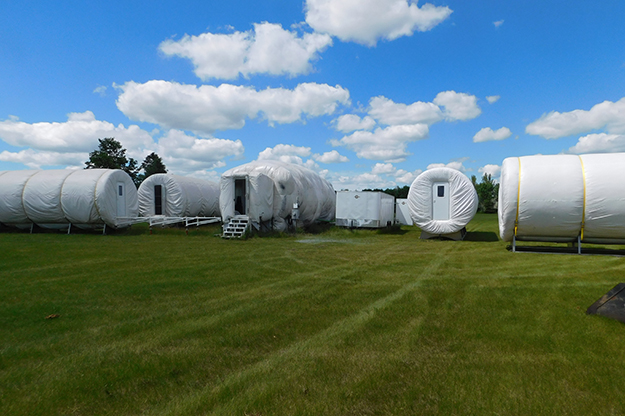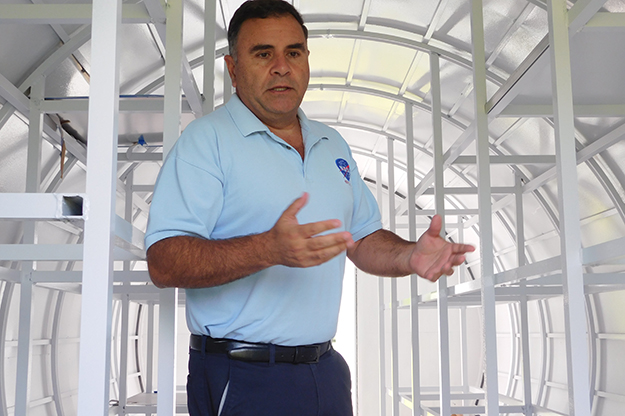Space station takes shape
UND Aerospace Engineer Pablo de León installing final modules of his NASA-funded inflatable lunar/Mars habitat
On several grassy acres near I-29 owned by the UND Aerospace Foundation, aerospace engineer and UND Aerospace faculty member Pablo de León leads a student team that’s assembled a series of “space” modules meant to simulate the closed environment of a planetary station. In this case, Mars.
It’s all part of an ongoing research project—the only one like in the nation—funded by the National Aeronautics and Space Administration (NASA) as part of its ambitious long-term plan to establish a human colony on Mars.
This UND-based project—the Inflatable Lunar-Mars Habitat, or ILMH—has been built and worked on by students. The heavy-duty fabricating and welding of all aluminum infrastructure has been done locally by Grand Forks Welding, which delivered the final plastic-sheeting wrapped unit to the ILMH in June.
“There are now a total of five modules, configured like an actual Mars base—a living module; an extra-vehicular activity (EVA) and maintenance module; a plant production module; an exercise and human performance module; and a geology module,” said de León, who besides his faculty appointment is director of the UND Human Spaceflight Laboratory in the John D. Odegard College of Aerospace Sciences. There, he and his team work on designing and building the planetary exploration suits essential to survival in the thin atmosphere of Mars, which is 96 percent carbon dioxide.
Additionally, two vehicles—also designed and built by UND Space Studies students—a crewed four-wheel electric powered rover and a four-wheel drive electric powered robotic rover.

How it all works
De León explains how this system works as follows:
- The core of this five unit project is the living module, where crew will spend a good portion of their time.
- The EVA and maintenance module is the workshop where the crew will perform both routine and emergency repairs and maintenance on suits, modules, rovers and other equipment.
- The plant production module is all about feeding the crew—of course, this means a plant-based diet. No room for meat animals.
“The plant production module will house trays of plants under LED lights specially designed by NASA,” noted de León—who said the Space Studies graduate degree program always has far more applicants than the program can accept.
“We will grow the plants under different conditions, and they will be temperature controlled over North Dakota’s winter,” he said. “Sensors with computers will record data related to plant progress, the pH of soil, humidity. They plants will then be harvested, cleaned and taken to habitat to be cooked and eaten.”
- The exercise and human performance module will house special exercise machines with systems that will feed information to NASA; the agency will be able to perform real-time monitoring of the health status of persons in the module.
- The geology module is for experiments and for developing techniques for cutting Martian rocks that may contain contaminants such as toxic perchlorates that should not be inhaled—particulates could be released as the rocks are gathered and cut, so the crew must process samples in a glove box.
All the modules are connected with aluminum-framed tunnels, already built and ready to be hooked up at the site.

Nuclear power
De León speculates that ultimately, small nuclear plants will generate the power for a Mars-based station like the one being tested at UND.
“On Mars, which is farther from Sun than Earth, wind would darken solar panels over time (constant cleaning of dust),” he said. “So with what we know now, a small nuclear plant would be the most practical. The fact is, we’ve using nuclear power for decades in space to power planetary probes and other space craft.”
The density of Mars’ atmosphere is low so nothing heavy can be moved by winds, so wind power is out of the question.
“You’d need wind turbine blades half a mile long or more,” de León said. “And Martian dust storms can last three months, so dust would accumulate on solar panels—reducing or eliminating their energy-generating capabilities. Moreover, none of machines to produce oxygen, purify water, would work in such an environment. Nuclear power would meet all those needs with low maintenance requirements.”
The project was first funded in 2009 by a three year $750,000 grant. Another $750,000 grant was awarded to the UND ILMH project in 2015.
Why UND?
UND is one of a few facilities funded by NASA to test long-duration Mars conditions, said de León.
“We have the talent pool, the facilities, the environment and climate that provide an optimum place to test the extreme technologies needed for such a hostile place as Mars,” said de León. “We collaborate with other universities and NASA centers on long-duration missions to actually test different technologies, systems and equipment that will facilitate our travel to, and stay on, Mars.”
Teams of students already have successfully completed 10-day and 30-day missions in the ILMH. De León says much longer multi-month missions are planned now that the ILMH’s five modules are in place.
“When it becomes fully operational, we’ll issue a nation-wide call for personnel to crew the habitat so that we can do long-duration missions on regular basis,” he said.
Today’s ILMH team consists of 11 graduate students, but several dozen have been through the Space Studies program. Most of those graduates now are working for NASA or for contractors such as Lockheed Martin and Boeing. The Space Studies program’s first Ph.D. student Kavya Manyapu (who works at Boeing in Houston) will defend her dissertation next month. Manyapu is an aerospace test engineer, a designer of Boeing Company’s Commercial Spacecraft, and a participant in the Mars Society research project that will someday prepare humans for life on Mars.


